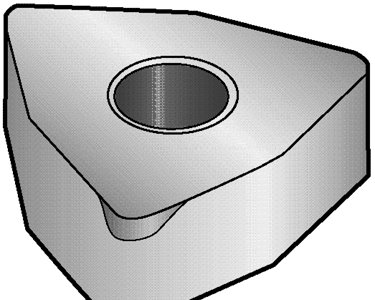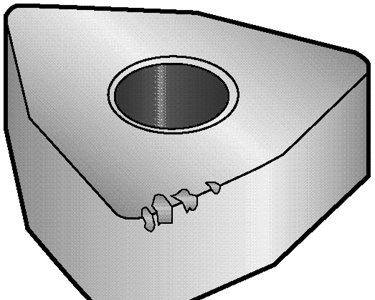Manage Tool Wear with Stainless Steel
When you're machining stainless steel, tool wear is predictable. Learn to recognize types of wear and help optimize your production.Many shops look at tool wear as a problem to overcome rather than a manageable, predictable part of metal cutting. In reality, all machining processes produce a wear pattern regardless of workpiece material. Stainless steel is more difficult to cut than low-alloy and carbon steels because of its hardness and thermal resistance. But once you know how stainless steels behave, you can achieve great – and predictable – machining results with these essential alloys.
It's almost a misnomer to call the process of machining stainless steel "cutting." Carbide tools actually deform the metal in front of them, which breaks off to form chips. The material surface undergoes strain hardening, often called work hardening. This phenomenon is common in stainless steel materials, more so than in any other material group.
Strain, or work, hardening underlies the wear patterns you see on your cutting tools. That's because stainless steel alloys are poor heat conductors. More byproduct heat stays in the cut and less of it dissipates through chips, which increases strain hardening. As a result, you can expect to increase tool and insert usage by between 10% and 20% when machining stainless steel. This leads to increased costs compared to simple steels.
So how do you manage your tool wear expectations when you cut stainless steel?
 "Safe" wear is controllable and measurable. When you understand stainless steel and cutting tools, you can anticipate three types of wear that fall into this "safe" category.
"Safe" wear is controllable and measurable. When you understand stainless steel and cutting tools, you can anticipate three types of wear that fall into this "safe" category.
Normal flank wear is the least problematic of all types of tool wear. At the lower cutting speeds that favor stainless steel, most flank wear results from abrasion and erosion.
With notch wear, localized contact between the cutting edge and the hardened surface causes equally localized wear. This stems from workpiece material that's not as hard or abrasive as its surface – the scenario that produces strain hardening.
Crater wear occurs when heat from chips decomposes the carbide insert and makes it take on carbon. This causes a crater to develop on the rake face of the insert.
 Some forms of wear are warning signs.
Some forms of wear are warning signs.
Built-up edge occurs when chips micro weld or cold weld onto the cutting edge. This may resemble chipping and can break off some of the carbide substrate of the tool. Built-up edge typically results from incorrect cutting parameters and overly slow cutting.
Instability and vibrations in the workplace, tool or machine tool cause chipping or cracking in the cutting edge.
Plastic deformation occurs when interrupted cutting introduces pressure and excess heat in the cutting zone and melts the binder in the cutting tool.
Finally, complex flank wear is flank wear that occurs too quickly. It looks like ordinary flank wear but signals that your machining process needs adjustment.
- Size matters in metal cutting. A larger, more robust, stronger tool cuts longer without chipping or breakage than a smaller, less-substantial tool. Choose the biggest possible mass of carbide to handle the byproduct heat generated in cutting.
- With a bigger, thicker insert, more heat dissipates in the insert instead of in the cutting edge. Look for dedicated geometries specially designed for use with stainless steel.
- Choose tooling with a tough carbide grade, not a wear-resistant one, to deal with the chip breakage and edge chipping from strain hardening.
- Select a strong insert with sharp geometries. A robust basic shape provides durability while a large rake angle aids sharpness. A large nose radius creates a stronger edge with greater edge protection.
- Control your cutting speed to extend tool life and improve machining. More speed produces more heat.
- Cut with small entry angles or the lazy edge of a CNMG insert to improve tool life.
- Large depths of cut enable the tool to get under the strain-hardened layer of the workpiece material.
- Higher feed rates mean larger chips, which help dissipate heat instead of leaving it in the cutting edge.
- Always use directed high-pressure coolant if at all possible, such as you'll find in Seco-Capto MTM JETI Toolholders.
Tool wear depends on many different factors, not just workpiece material, so you need to investigate its cause. To optimize your tooling and handle tool wear effectively, consult the Seco Assistant app. The Tool Optimization feature helps you select cutting parameters and recognize wear patterns. Search for product line, challenge or tool wear. Select the tool you’re using and get tips on how to overcome the challenge.
Tool wear results from more than a single factor, so skilled machinists often rely on their own experience. If you’re unsure about tool wear while machining stainless steel, check with colleagues or combine your machining knowledge with expertise from Seco.
Contact us now